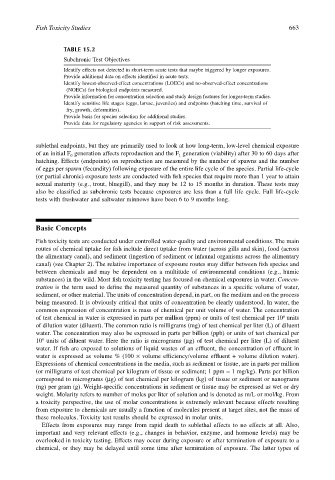Page 683 - The Toxicology of Fishes
P. 683
Fish Toxicity Studies 663
TABLE 15.2
Subchronic Test Objectives
Identify effects not detected in short-term acute tests that maybe triggered by longer exposures.
Provide additional data on effects identified in acute tests.
Identify lowest-observed-effect concentrations (LOECs) and no-observed-effect concentrations
(NOECs) for biological endpoints measured.
Provide information for concentration selection and study design features for longer-term studies.
Identify sensitive life stages (eggs, larvae, juveniles) and endpoints (hatching time, survival of
fry, growth, deformities).
Provide basis for species selection for additional studies.
Provide data for regulatory agencies in support of risk assessments.
sublethal endpoints, but they are primarily used to look at how long-term, low-level chemical exposure
of an initial F generation affects reproduction and the F generation (viability) after 30 to 60 days after
0
1
hatching. Effects (endpoints) on reproduction are measured by the number of spawns and the number
of eggs per spawn (fecundity) following exposure of the entire life cycle of the species. Partial life-cycle
(or partial chronic) exposure tests are conducted with fish species that require more than 1 year to attain
sexual maturity (e.g., trout, bluegill), and they may be 12 to 15 months in duration. These tests may
also be classified as subchronic tests because exposures are less than a full life cycle. Full life-cycle
tests with freshwater and saltwater minnows have been 6 to 9 months long.
Basic Concepts
Fish toxicity tests are conducted under controlled water-quality and environmental conditions. The main
routes of chemical uptake for fish include direct uptake from water (across gills and skin), food (across
the alimentary canal), and sediment (ingestion of sediment or infaunal organisms across the alimentary
canal) (see Chapter 2). The relative importance of exposure routes may differ between fish species and
between chemicals and may be dependent on a multitude of environmental conditions (e.g., humic
substances) in the wild. Most fish toxicity testing has focused on chemical exposures in water. Concen-
tration is the term used to define the measured quantity of substances in a specific volume of water,
sediment, or other material. The units of concentration depend, in part, on the medium and on the process
being measured. It is obviously critical that units of concentration be clearly understood. In water, the
common expression of concentration is mass of chemical per unit volume of water. The concentration
of test chemical in water is expressed in parts per million (ppm) or units of test chemical per 10 units
6
of dilution water (diluent). The common ratio is milligrams (mg) of test chemical per liter (L) of diluent
water. The concentration may also be expressed in parts per billion (ppb) or units of test chemical per
10 units of diluent water. Here the ratio is micrograms (µg) of test chemical per liter (L) of diluent
9
water. If fish are exposed to solutions of liquid wastes of an effluent, the concentration of effluent in
water is expressed as volume % (100 × volume efficiency/volume effluent + volume dilution water).
Expressions of chemical concentrations in the media, such as sediment or tissue, are in parts per million
(or milligrams of test chemical per kilogram of tissue or sediment; 1 ppm = 1 mg/kg). Parts per billion
correspond to micrograms (µg) of test chemical per kilogram (kg) of tissue or sediment or nanograms
(ng) per gram (g). Weight-specific concentrations in sediment or tissue may be expressed as wet or dry
weight. Molarity refers to number of moles per liter of solution and is denoted as m/L or mol/kg. From
a toxicity perspective, the use of molar concentrations is extremely relevant because effects resulting
from exposure to chemicals are usually a function of molecules present at target sites, not the mass of
these molecules. Toxicity test results should be expressed in molar units.
Effects from exposures may range from rapid death to sublethal effects to no effects at all. Also,
important and very relevant effects (e.g., changes in behavior, enzyme, and hormone levels) may be
overlooked in toxicity testing. Effects may occur during exposure or after termination of exposure to a
chemical, or they may be delayed until some time after termination of exposure. The latter types of

